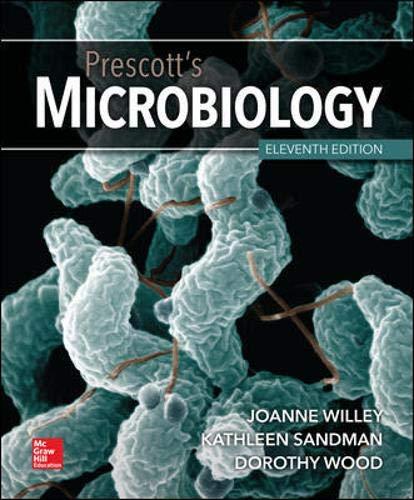
Prescott's Microbiology
11th Edition
ISBN: 9781260211887
Author: WILLEY, Sandman, Wood
Publisher: McGraw Hill
expand_more
expand_more
format_list_bulleted
Concept explainers
Question
Chapter 23.2, Problem 3CC
Summary Introduction
Staphylococcus is a Gram-positive bacteria and it belongs to the Staphylococcaceae family. It contains five genera. Members of Staphylococcus are nonmotile cocci, facultative anaerobic organisms (capable of growing in both anaerobically and aerobically), size ranges from 0.5 to 1.5 µm in diameter. Generally, it oxidase negative and catalase positive.
Expert Solution & Answer
Want to see the full answer?
Check out a sample textbook solution
Students have asked these similar questions
Describe four enzymes produced by Staphylococcus, and explain how each contributes to the bacterium’s survival and pathogenicity.
While it is true that not all coliforms are pathogenic under normal conditions, please name two situations that can occur due to infection by pathogenic strains.
Differentiate Staphylococcus from Micrococcus and Streptococcus
Chapter 23 Solutions
Prescott's Microbiology
Ch. 23.1 - MICRO INQUIRY Refer to table 24.2 and determine...Ch. 23.1 - MICRO INQUIRY Why do Mycobacterium spp. have...Ch. 23.1 - Prob. 3MICh. 23.1 - Prob. 1.1CCCh. 23.1 - Prob. 1.2CCCh. 23.1 - Retrieve, Infer, Apply Why are actinobacteria of...Ch. 23.1 - Prob. 1.4CCCh. 23.1 - Retrieve, Infer, Apply Compare the morphology and...Ch. 23.1 - Prob. 1.6CCCh. 23.1 - Prob. 1.7CC
Ch. 23.1 - Prob. 1.8CCCh. 23.1 - Retrieve, Infer, Apply List the distinguishing...Ch. 23.1 - Prob. 2.2CCCh. 23.1 - Prob. 2.3CCCh. 23.1 - Retrieve, Infer, Apply Describe three ways in...Ch. 23.1 - Briefly describe the defining properties of genera...Ch. 23.1 - Prob. 2.6CCCh. 23.1 - Examine the ingredients list on a commercial...Ch. 23.2 - What growth or survival advantage might this type...Ch. 23.2 - What is the net yield of ATP for each glucose that...Ch. 23.2 - Prob. 3MICh. 23.2 - Prob. 1CCCh. 23.2 - Prob. 2CCCh. 23.2 - Prob. 3CCCh. 23.2 - Prob. 4CCCh. 23.2 - How are various species of Streptococcus...Ch. 23.2 - Of what practical importance are leuconostocs?...Ch. 23.2 - What is the difference between -hemolysis and...Ch. 23.3 - The presence of an electron transport chain in a...Ch. 23.3 - In addition to its Gram-staining characteristics,...Ch. 23.3 - What are the two sources of electrons for the H....Ch. 23.4 - Prob. 1CCCh. 23.4 - Suggest why C. tetani uses a sodium motive force...Ch. 23.4 - Prob. 3CCCh. 23.4 - What kind of genetic evidence, in addition to 16S...Ch. 23 - Prob. 1RCCh. 23 - Prob. 2RCCh. 23 - Prob. 3RCCh. 23 - Prob. 4RCCh. 23 - Prob. 5RCCh. 23 - Prob. 6RCCh. 23 - Prob. 7RCCh. 23 - Prob. 8RCCh. 23 - Prob. 9RCCh. 23 - Prob. 10RCCh. 23 - Even though actinobacteria are high G + C...Ch. 23 - Given that mycolic acids are essential for...Ch. 23 - Prob. 3ALCh. 23 - Prob. 4ALCh. 23 - Prob. 5ALCh. 23 - What physiological properties might account for...Ch. 23 - S. aureus strains that are resistant to...Ch. 23 - Prob. 8AL
Knowledge Booster
Learn more about
Need a deep-dive on the concept behind this application? Look no further. Learn more about this topic, biology and related others by exploring similar questions and additional content below.Similar questions
- How could species of Staphylococcus be differentiated fromStreptococcus?arrow_forwardList the four genera of bacteria that cause opportunistic infectionsand are physiologically similar to Pseudomonas.arrow_forwardName three taxa of bacteria that are downregulated in CF patients and list their phylum.arrow_forward
- What are the common pathogens isolated from stool samples? What is the difference between a coliform bacterium and a noncoliform enteric bacterium? What diagnostic test differentiates Proteus and Providencia species from other Enterobacteriaceae? How would you differentiate between serotypes of E. coli? Are the gram-negative enteric bacilli fastidious organisms? Would they survive well outside of the body? If so, what significance would this have in their transmission? Why is serotyping particularly important in Salmonella infections and typhoid fever?arrow_forwardWhat did Staphylococcus avoid characteristics and descriptions of laboratory procedures and method Staphylococcus? Are the healthcare concerns, infections, and nosocomial infections discussed for genera Staphylococcus? Does Staphylococcus avoid characteristics and descriptions of laboratory procedures and methods?arrow_forwardHow does one can differentiate Staphylococcus aureus from Bacillus subtilisarrow_forward
- What did Staphylococcus avoid characteristics and descriptions of laboratory procedures and method Staphylococcus? Are the healthcare concerns, infections, and nosocomial infections discussed for genera Staphylococcus? What does specific examples from Staphylococcus genus discussed with regard to specific conditions and concerns and not only with an overview of the entire genus?arrow_forwardWhat are some Important facts about staphylococcus capitis? Why are they significant?arrow_forward
arrow_back_ios
arrow_forward_ios
Recommended textbooks for you

Mechanisms of Pathogenicity: Microbiology; Author: Dr. Frank O'Neill GrowGrayMatter;https://www.youtube.com/watch?v=SDyl0JNCeho;License: CC-BY